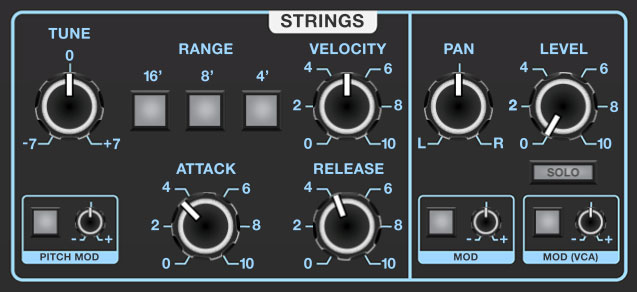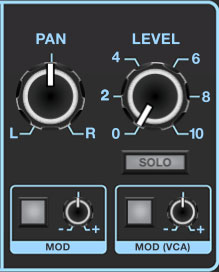
The Strings section emulates a classic, “top-octave divide” string synthesizer. Like vintage string synths, the signal is routed to an always-on "tri-chorus" - a clever and really great-sounding implementation of chorus seen in a number of 70s strings machines that used three BBD delay chips with six modulation sources to create that lovely, syrupy string chorus sound made famous by the Solina String Synthesizer.
The Strings tri-chorus is entirely separate from the Mod Effect chorus in the bottom row (and has no external panel controls), but the Strings section can still be routed through the Mod Effect section, because far be it from us to stop you from double-chorusing for your fab new tribute band, "Cure Division: Everything More Chorused Than Everything Else."
Tune- Allows fine-tuning of pitch or creating intervals between Wave A and Wave B. It's also useful for fattening up multi-oscillator patches by detuning a small amount. Its range is a smidge over a fifth, up or down.
Pitch Mod Source button and attenuator knob- Allows positive or inverted modulation of the Tune knob. Clicking one of the small square buttons opens a pop-up menu where the mod source can be selected. The attenuator knobs next to buttons set a positive or inverted mod amount for the selected mod source. To choose a different mod source, click the button and choose another modulator, or choose None to disable modulation. The button turns green to indicate a mod source is currently active; hovering over the button displays the current mod source.
Range- These select the octave range, displayed in standard organ footages. Multiple ranges can be enabled in any combination.
Attack / Release - The Strings section envelope generator is an “AR,” or attack/release envelope. The Attack Time slider defines the length of time to reach maximum amplitude; the Release Time slider defines the length of time until amplitude falls to zero following key release. Notes will sustain at full volume as long as keys are held.
Unlike many classic "paraphonic" string synthesizers, Dreamsynth's Strings section features individual AR envelope generators for each of its 16 voices of polyphony. This enables fully independent amplitude articulation for all individual notes. (Phew, that was a mouthful of wordverbalsyntax.)
Velocity- Defines how much the envelope affects the amplitude via keyboard velocity. When set to zero, keyboard velocity has no effect on amplitude; all the way up results in maximum control range.
Strings Pan and Level Controls

Pan and Mod box - Sets the Strings panning position left to right. The Mod box beneath the Pan knob allows modulation of pan position.
Level and Mod (VCA) box - Sets the overall Strings volume. The Mod box beneath the Level knob allows volume modulation - this essentially means the Strings section has its own independent voltage-controlled amplifier (VCA), and like the oscillator VCA's, this offers a lot of sound flexibility (like mangling the strings with pink noise as a mod source, for example).
Solo button- When toggled, the Solo button disables the synth oscillators. It's useful when programming patches. Note that the Strings and synth oscillator Solo buttons can be combined as desired.